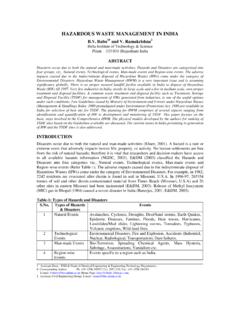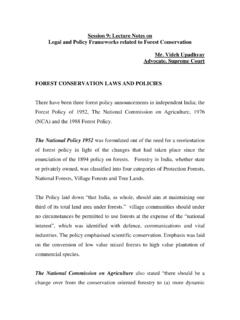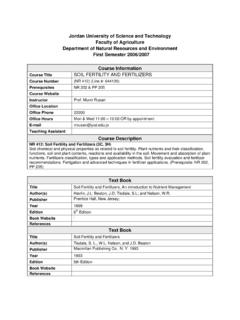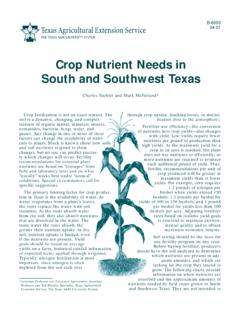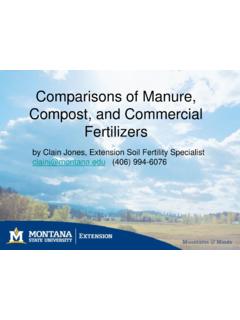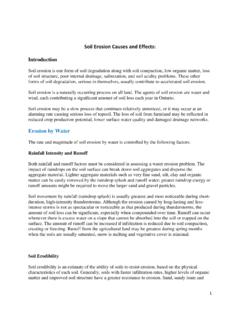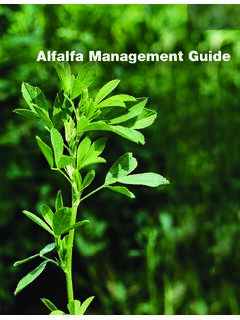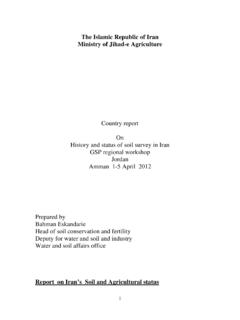Transcription of Better Management Practices in Sugarcane Farming …
1 Better Management Practices in Sugarcane Farming Systems 2 Better Management Practices in Sugarcane Farming Systems Content Chapter Page No. I. Introduction 1 II Improved Planting Technique 2 III Soil Management 7 IV Nutrient Management 8 V Irrigation Water Management 10 VI Interculture & Weed Control 29 VII Maturity & Harvesting 30 VIII Integrated Pest & Disease Management 31 IX Management of Ratoon Crop 35 X References 37 3I. INTRODUCTION Maharashtra is one of the leading states in sugar and Sugarcane production in India. Sugarcane industry in Maharashtra is second largest agro-based industry next to cotton in which higher investment is made and has brought about desirable changes in social, economical, educational and political life in rural areas. In Maharashtra the highest harvested cane yields by farmers for Adsali/pre-seasonal; Suru and Ratoon have been 269, 217 and 202 T/ha respectively.
2 However, the average yield of the State is about 85T/ha. Thus there is wide gap between the average yields and potential yield. These production potential can be achieved by adopting Better irrigation water Management and scientific crop production Practices . The consumptive water needs of seasonal (one year) Sugarcane are between 1600 2000 mm in Maharashtra State depending upon agro climatic conditions. After effective rainfall, the annual net irrigation requirement is only 1200 to 1600 mm. Considering 20% field application losses, 1400 to 2000 mm is enough under surface irrigation condition. Farmer s water use is 3000 to 4000 mm. It shows enormous wastage of water resource. The excess application result in water logging and salinity in the farm. These are man made problems. Adoption of any one of the modern irrigation techniques such as straight ridges and furrows with gentle slope, contour furrows, leveled furrows, drip irrigation and a combination of sprinkler plus straight furrows can reduce these problems.
3 Adoption of modern irrigation techniques and best Management Practices will save about 50% water use on farm and will almost double the Sugarcane yield. 4II. Improved planting techniques 1. Planting Time In Maharashtra, Sugarcane is planted at three different times as given below. Planting /Ratoon Harvesting Seasonal (December to 15 February) February to April Pre-seasonal ( 15 October to 15 November) October to January Adsali (July August) October to January Ratoon (Ratoon of cane harvested during October to February) November to April (depending upon maturity) 2. Varieties Any of the following varieties may be selected. Variety Characteristics CO 86032 Resistant to smut and grassy shoot diseases, good ratooner, can sustain water stress, non-flowering. CoC 671 Early maturity, moderately susceptible to smut, grassy shoot and stem borer (Recommended by Vasantdada Sugar Institute).
4 CO 94012 Resistant to smut and stem borer, good ratooner, low flowering, high sugar recovery. 3. Method of planting Dry method of planting should be followed. Sets should be placed 5 to cm deep into soil. Care should be taken to place eye buds on side and covered with thin layer of soil and then irrigation should be given to the field. 54. Seed rate Single, two and three eye bud methods of planting are in practice. To avoid heavy risk of gaps in single eye bud and over population by three eye bud planting methods, two eye bud method is recommended. About 25,000 two eye budded sets will be required to plant one hectare area. Only upper half or two third cane should be selected for planting as shown below. 6 While preparing set, care should be taken to maintain minimum distanc (one third inter node) above the eye bud and maximum distance below the eye bud (two third inter node) so as to obtain high germination. 5. Spacing Depending upon the soil type and method of irrigation, appropriate spacing should be adopted as given below.
5 Soil type Method of irrigation Furrow spacing Method of placement of set Spacing between two sets Coarse to medium textured soils Surface 90 cm Parallel to furrow cm Fine textured soils Surface 150 cm Across the furrow cm All kinds of soils Drip Paired row 75 cm X 150cm Parallel to furrow cm 7 Normal furrow Wider furrow Paired row In 75 or 90 cm furrows sets should be placed cm apart as shown below. In wider furrows (150 cm), sets should be placed across the length of furrow as shown below. 86. Seed treatment Seed treatment with hot water at 51 oC for two hours or moist air treatment at 54 oC for 21/2 hours. Sets should be dipped in solution of Bavistin (10 g Bavistin in 10 litres of water) or Bayleton ( ) (5 g Bayleton in 10 litres of water) for 10 to 15 minutes. If sets are infested with scale insect or wooly aphids, sets should be dipped in solution of Malathion ( 50EC), 30 ml or Dimethoate ( 30EC), 27 ml in 10 litres of water for 10 to 15 minutes.
6 If fresh sets are not available for planting, sets should be dipped in solution of 500 g lime in 200 litres water for 12 to 24 hours. To increase biological nitrogen fixation and solubility of phosphatic fertilizers, setts should be treated with Azatobacter and Phosphate solubilising inoculants. For one hectare area, dissolve 10 kg Azatobacter and 10 kg P-solubilising inoculant in 100 litres of water and dip sets for 10 15 minutes and then do planting after drying them in shade. 9 III. Soil Management 1. Suitability of soil Medium to fine textured, deep (depth > 1 m), rich in organic matter status, well drained, having pH between to are ideal for Sugarcane crop. Growing Sugarcane on coarse textured, shallow soils will result in poor yield. The crop is sensitive to soil salinity and sodicity. Sugarcane crop does not suffer as long as electrical conductivity of saturation extract of soil (ECe) is up to millimhos/cm.
7 Similarly exchangeable sodium percentage (ESP) of soil should be less than 15% for Better crop production. Quality of irrigation water (surface and ground water) should necessarily be less than millimhos/cm in its electrical conductivity for irrigation of Sugarcane crop on fine textured deep soils under semi-arid conditions. Depth to ground water in Sugarcane crop fields should be more than 3 m. 2. Preparatory tillage As Sugarcane crop stands in field for more than a year, it is necessary to give deep ploughing by iron mould board plough drawn by bullocks or tractor. If preceding crop is a green manure crop, ploughing is not necessary as for burring green manure crop ploughing is required. The proper time for ploughing is immediately after the preceding crop is harvested or just after a good shower of rain is received. The land is then exposed to atmosphere for a month or two and then harrow is worked three to four times to break clods and to make the land smooth and even.
8 Before last harrowing, recommended dose of organic manure is applied and mixed well with soil. Furrows at required distance depending upon the spacing are then opened across the major slope. 10IV. Nutrient Management 1. Organic manures Application of organic manures for maintenance of soil at high fertility level is almost essential. Organic manures improve physical, chemical as well as biological properties of soil. Organic manures @ 20 to 25 tonnes/ha are to be applied in different forms like Farm Yard Manure/Compost/Dung Manure. Press mud can also be used as an organic manure @ 5 tonnes/ha particularly useful in saline alkali soils. Sugarcane trash can be used as a mulch and sprayed with 80 kg urea, 100 kg Single Super Phosphate and 10 kg decomposing culture/ha for Better decomposition. Sugarcane trash can also be incorporated while making organic manure along with press mud and use of earthworms for preparing vermicompost.
9 Crops like sannhemp and dhaincha are grown as green manure crop. Green manure crops can be grown as a sole crop and buried in the field at an age of to 2 months (before flowering) followed by Sugarcane crop. These can also be grown along with Sugarcane by sowing in rows in between two rows of Sugarcane and burring in soil at the time of earthing up. On an average, 20 tonnes of green matter and 90 kg nitrogen is added by growing green manure crop. 2. Fertilizers The dose (kg/ha) and time of application of fertilizers is as below: Adsali Pre seasonal Seasonal/Ratoon Sr No Time of application N P2O5 K2O N P2O5 K2O N P2O5 K2O 1 At planting 50 100 100 40 85 85 35 70 70 2 6 8 weeks after planting 200 - - 160 - - 140 - - 3 12 16 weeks after planting 50 - - 40 - - 35 - - 4 At earthing up 200 100 100 160 85 85 140 70 70 Total 500 200 200 400 170 170 350 140 140 11 Precautions to be taken while applying fertilizers Always fertilizers should be well mixed with soil and applied 4 5 cm deep in the soil.
10 Apply fertilizers when soil is moist. On the next day of fertilizer application, give light irrigation. While applying Urea fertilizer, it should be mixed with Neem cake in 6 : 1 proportion. Mixing phosphatic fertilizers with compost or dung manure is beneficial. During periods of water stress, additional dose of 125 kg Muriate of potash fertilizer should be applied. If green manure crop is planned, recommended dose of phosphorus for Sugarcane crop should be applied as below 25% dose to green manure crop 25% dose to Sugarcane crop at planting 50% dose to Sugarcane crop at earthing up. Soil test based fertilizer recommendations should be followed. In soils deficient with micro nutrients like iron, zinc, manganese, copper, molybdenum and boron, in addition to above fertilizers, 25 kg Ferrous Sulphate, 20 kg Zinc Sulphate, 10 kg Manganese Sulphate, 10 kg Copper Sulphate kg, Sodium Molybdate and 5 kg Borax per hectare should be applied.
